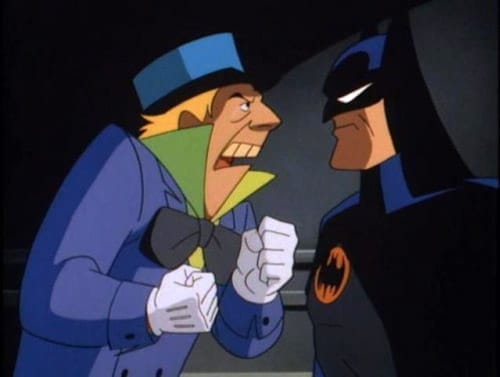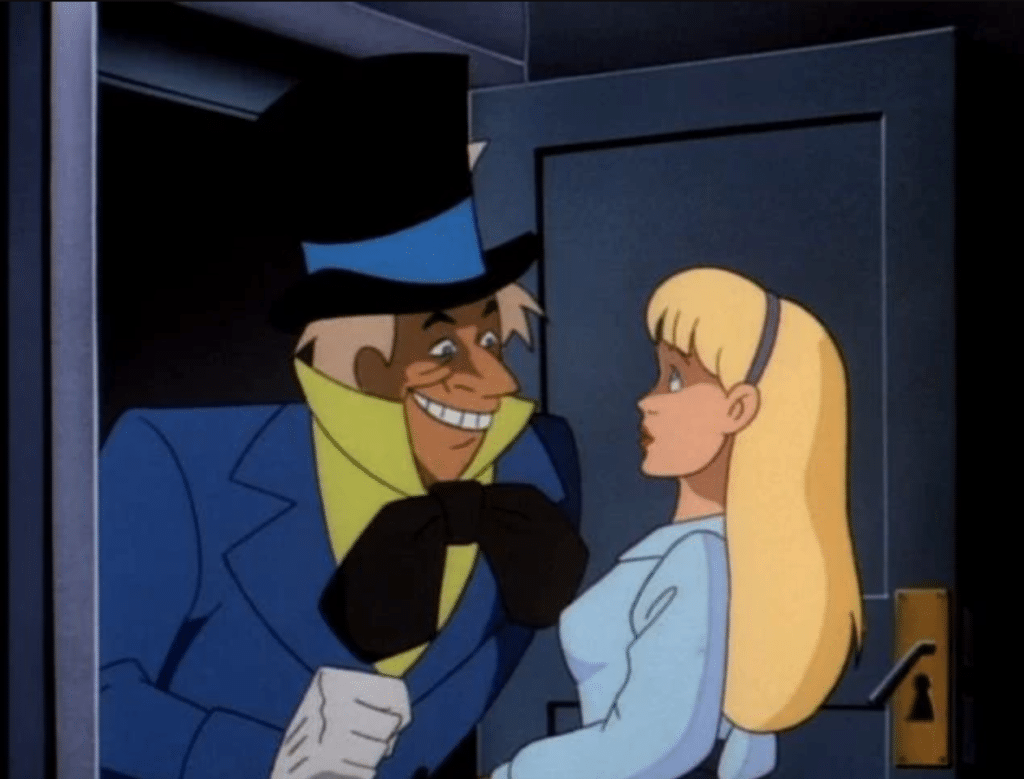Sometimes in the far reaches of space, two stars orbit each other closely and, over time, spiral inward until they collide, creating a magnetic field more than a trillion times stronger than Earth. The subsequent explosion is called a gamma-ray burst, the brightest and most energetic type of event since the Big Bang. The result? It can form a black hole, a body of pure nothingness where not even light can escape. Or the collision can create a brand new neutron star, bigger and heavier than before.
What does this have to do with Alice in Wonderland? Well, in 1948 Lew Sayre Schwartz and comic book pioneer Bill Finger engineered a stellar collision of their own when they turned Lewis Carroll’s Mad Hatter into a villain for Batman #49. The joining of Wonderland and Gotham was like two pop culture stars slamming into each other, producing a massive gamma-ray burst and creating a new, compelling take on an iconic character. Forty-four years after the Mad Hatter first terrorized Gotham, Paul Dini brought him to the screen in Season One of the groundbreaking show, Batman: The Animated Series.

The Mad Hatter of Batman: The Animated Series (BTAS) is more grounded than in Carroll’s books, shaped to fit within the more realistic parameters of the noir-tinted cartoon. Hatter is the evil persona of Jervis Tetch, who is first introduced as a socially awkward but brilliant scientist developing mind-control chips for Wayne Enterprises. Tetch is a devotee of Lewis Carroll’s works and is obsessed with the office executive assistant, Alice, who (obviously) has blonde hair with bangs and wears a blue dress.
Tetch’s first appearance comes in the Season One episode, “Mad as a Hatter '', in which transformation into the villainous Hatter takes place. Tetch is overjoyed when he learns that Alice and her boyfriend, Billy, have broken up and uses his mind control chips in an effort to impress her on a night town. He plays the bigshot, putting chips on servers, photographers, the maitre d’, and anyone who makes him look important to Alice. But he is driven mad with rage and jealousy when Alice reveals that she and Billy made up. Worse, they’re engaged. Tetch uses his mind control technology to make Billy dump Alice (again) and later kidnaps her. Batman becomes suspicious of Tetch when he connects the mind control cards to an illustration of Alice in Wonderland in Tetch’s office showing the Mad Hatter with the same type of card in his hat. Batman confronts Tetch in “Wonderland”, a section of the Gotham Storybook Land amusement park. After a thrilling fight, Batman throws his Batarang at the cords holding up a large Jabberwock statue. The Batarang cuts the cords and the statue falls on Tetch, trapping him. Batman frees Alice and Billy from Tetch’s mind-control devices and Tetch is thrown into Arkham Asylum.

“Mad as a Hatter” is overflowing with references to Alice. Tetch constantly quotes the books, muttering “curiouser and curiouser” when he finds Alice crying about her break-up and exclaiming “Callooh! Callay! O frabjous day!” after his first “date” with her. As he descends into madness, Tetch dresses his henchmen as Alice characters including the Walrus and the Carpenter, Cheshire Cat, Caterpillar, the White Rabbit, and the Red Queen. Finally, when his defeat is clear, Tetch quotes the “Lobster Quadrille,” lamenting that he “could not join the dance.” For fans of Alice easter eggs, this episode is like being alone at an easter egg roll.
Writers Laren Bright and Michael Reaves continued to mine Carroll’s themes and devices in Hatter’s second appearance, “Perchance to Dream”. It opens with Batman being knocked out and waking up in a “Wonderland,” one where Batman is someone else, he (Bruce Wayne) is engaged to Selina Kyle, and his parents are still alive. Though tempted to remain in this “perfect” world, Bruce can’t shake the idea that something is wrong. He eventually deduces that he is stuck in a dream world. He confronts “Batman” and it turns out that the Caped Crusader is none other than Jervis Tetch, who has (predictably) escaped from Arkham Asylum. Tetch used his mind control technology to create a dream world for Bruce to keep Batman out of his own life. Bruce breaks out of the dream world and defeats Tetch in the real world, leading to Tetch being arrested again and sent to Arkham. The episode is a beautiful exploration of love and loss and shows the potential of using established works to enrich another storytelling world.

In “The Worry Men” Hatter escapes from Arkham again (they really need to do something about the security in that place) and travels to South America, where he brainwashes the wealthy Veronica Vreeland into transporting Worry Men dolls back to Gotham and giving them out to her high society friends. The dolls contain Hatter’s brainwashing chips, resulting in Gotham’s wealthy elite funneling $100 million to Tetch/Hatter. But once Batman realizes that he has been hoodwinked into sending Tetch money, he tracks down the mad villain and makes him pay for his crimes.
The Mad Hatter’s final appearance as a main villain in Batman: The Animated Series comes in the Season Two episode “Trial”. He uses his mind control chips to brainwash the Arkham guards (again, that facility really needs a security audit) so that he and other icons of the Gotham rogues gallery can take control of the asylum. They kidnap District Attorney Janet Van Dorn, well known for her anti-Batman beliefs, and later lure the Dark Knight to Arkham where he is arrested. The villains then put Batman on trial for being responsible for their various conditions and evil deeds, calling to mind the Red Queen’s kangaroo court in Alice’s Adventures in Wonderland. Despite her dislike of Batman, Van Dorn defends him and, to everyone’s surprise, gets him acquitted, though Batman is still forced to fight his way out after the Joker and other villains decide to disregard the “verdict”.

The Mad Hatter in Batman: The Animated Series is an excellent example of using existing I.P. to create something fresh and exciting. The writers and producers of BTAS took the iconography and themes from Lewis Carroll’s work and perfectly grafted them onto the world of their show. The Alice references in “Mad as a Hatter” fueled a thoroughly entertaining adventure. Their use of dreams and a “Wonderland” in “Perchance to Dream” is a perfect marriage of Carroll’s themes and the tragedy of Bruce Wayne/Batman’s life. Their grounded construction of Jervis Tetch/the Mad Hatter delves into the birth of madness, imbuing the character with the intensely human emotions of jealousy and obsession, which motivate his transformation into the insane milliner.

An itinerant storyteller, John Drain attended the University of Edinburgh before studying film at DePaul University in Chicago and later earned an MFA in Screenwriting from the American Film Institute Conservatory. John focuses on writing mysteries and thrillers featuring characters who are thrown into the deep end of the pool and struggle to just keep their heads above water. His work has been recognized by the Academy Nicholls Fellowship, the Austin Film Festival, ScreenCraft, Cinestory, and the Montreal Independent Film Festival. In a previous life, John created and produced theme park attractions across the globe for a wide variety of audiences. John keeps busy in his spare time with three Dungeons and Dragons campaigns and a seemingly never-ending stack of medieval history books.